by Heather Plett | Dec 29, 2014 | Creativity, grace, gratitude, grief, growth, mandala, Uncategorized
“Life can only be understood backwards; but it must be lived forwards.” ― Søren Kierkegaard
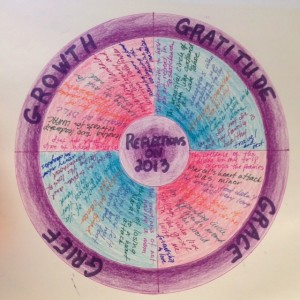 Last year, as the year ended, I shared a special mandala prompt for reflecting on the passing year before you invite in the new year. In that prompt, you were invited to divide your circle into 4 quadrants, with the words “grace, grief, growth, and gratitude” in each of the four quadrants. Then, with some reflection of the year that had passed, you filled each of the four quadrants with the things that happened that were connected to those four words.
Last year, as the year ended, I shared a special mandala prompt for reflecting on the passing year before you invite in the new year. In that prompt, you were invited to divide your circle into 4 quadrants, with the words “grace, grief, growth, and gratitude” in each of the four quadrants. Then, with some reflection of the year that had passed, you filled each of the four quadrants with the things that happened that were connected to those four words.
The process of filling those four quadrants helps you see the year for ALL that it was, not just the happy things and not just the hard things. Sometimes we get stuck in only one story and we assume that that story defines us, but each of us walks through many stories and each of those stories teaches us something. Life is never a perfect balance, but it’s also never only one of those four things.
That reflection mandala is now a part of A Soulful Year: A Mandala Workbook for Ending one Year and Welcoming Another. Before you begin the process of planning for what’s ahead, it’s valuable to reflect on what has passed and on what those events have taught you.
The Reflection Mandala is a useful process to do every year at this time. Take some time this week to create your own simple four quadrant mandala for 2014. Many of us have kept gratitude journals, and that is a beautiful practice that has been transformational in my own past, but sometimes that’s not enough. This practice offers an extension of that, where focusing not only on the gratitude, but on the grief and growth and what may have been really hard to walk through helps us recognize all of the complexity of our lives and all of the things that change us and stretch us.
Here’s an idea for extending the practice of reflecting on grace, growth, gratitude, and grief throughout the year…
Reflection Jars
Find, buy, or make four containers that you can keep on your desk, bookshelf, or nightstand. (I purchased 4 small jars at the dollar store for $2.)
Write (or print stickers, as I did) the words grace, grief, gratitude, and growth on each of the containers. Embellish the containers however you wish.

Cut up small pieces of paper that you can keep in an envelope close to your containers.
On a regular basis throughout the year (daily or weekly), reflect on how grace, grief, gratitude, and growth have been present for you. Write notes on slips of paper and slip them into which ever jar that reflection belongs in. You can do all four each day, or just do the ones that most apply to that day. Try to maintain a reasonable balance, filling each jar instead of focusing on only one.
Here are some prompts for the four categories:
Gratitude
This one is simple – what are you grateful for today? What made you happy? Who showed love or compassion? What did you have fun doing?
Grace
A simple definition of grace is “anything that shows up freely and unexpectedly that you did nothing to earn”. It can be a beautiful sunset that catches you by surprise as you’re driving home, an unexpected kind gesture from a friend, or forgiveness that you don’t feel like you deserve. What was unexpected and unearned? How did the beauty of the world stop you in your tracks? How did friends extend undeserved forgiveness or offers of help?
Grief
What made you sad? Who do you miss? What feels broken? What old wounds are showing up? What did you lose? What disappointed you?
Growth
What stretched you? What did you learn? What were your a-ha moments? Who served as your teacher? How did you turn hard things into opportunity for growth?
Fill your jars with meaning throughout the year.
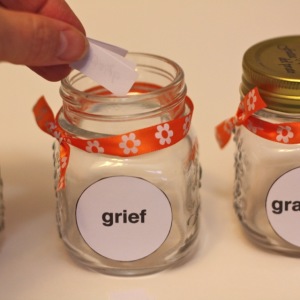 It’s quite possible that some items will show up in multiple jars. For example, something that causes grief will probably also offer you opportunities to grow. And sometimes (like when friends show up to support you) grace shows up in the darkest of moments.
It’s quite possible that some items will show up in multiple jars. For example, something that causes grief will probably also offer you opportunities to grow. And sometimes (like when friends show up to support you) grace shows up in the darkest of moments.
Keep the containers in a place where they’ll be visible and easy to access and where you’ll remember to fill them up. You might want to do this as a morning practice before you start your day or an evening practice as you reflect on the day that passed.
At the end of the year, create a new four-quadrant mandala, take all of the pieces out of the jars and write or glue them onto the mandala. Reflect on your well-balanced year.
Start filling the jars again next year.
Once you’ve reflected on the year that passed, you may want to continue with a variety of other processes that will help you welcome and plan for what wants to unfold in 2015. A Soulful Year may help.
If you’d like to receive a mandala prompt every day in January 2015, consider signing up for Mandala Discovery.
by Heather Plett | Dec 22, 2014 | mandala
It’s true – I think in circles. The circle, in some form, shows up in almost everything I do. When I need to connect with Spirit, I walk the labyrinth. When I want to connect with others, I gather people in circle. When I want to connect with myself, or I want to bring my swirling ideas into some form of clarity, I make mandalas. In this post, you’ll see how I used mandala-journaling to help process the ideas that are emerging in the book I’m writing. Any of the ideas in this post can be used for your own project planning, whether you’re writing a book, starting a business, or just trying to gain clarity about a new direction your life is taking. If these ideas tweak your interest, you may want to consider signing up for Mandala Discovery (which starts January 1st), or you may want to use A Soulful Year to help you release 2014 and plan for 2015.
Last week, when I went on my personal retreat, I didn’t plan to spend most of the three days in the art room with scissors, glue, markers and chalk pastels, but that’s where I was and it was the best place I could be. By the end of the weekend, I’d made 10 large mandalas, all ranging between two and three feet across.

My primary focus for my time away was the book I’d worked on so diligently for a couple of years and then set aside after my mom died because… well… because it just wasn’t feeling like I’d taken it where I needed to take it and because grief was clouding my judgement and focus. With a two year break, it felt like it was time to revisit it. It was one of those unfinished projects that just wouldn’t rest easily until it was resolved.
When I first arrived at the retreat centre on Monday morning, I headed toward the art room down the hall. I’ve been doing these personal retreats for about 10 years now, and there’s one thing I’ve learned – it takes time to settle in to the stillness of retreat. The first few hours are always full of restlessness and monkey-mind – “Did I remember to buy bus tickets for the kids? Do I need to check in on them? What if I don’t use my time here wisely and it’s a waste? Should I have a schedule so I get stuff accomplished while I’m here? Should I have spent this money so close to Christmas? Speaking of Christmas, maybe I should be finishing the shopping instead. Etc., etc.”
The best way I’ve found to deal with monkey-mind is to distract her with art supplies, which is why I love going to a retreat centre where the art room is just down the hall from my bedroom (and the library is at the other end of the hall). Inspired by the online Dreamwheel circle Lisa Rough was hosting on Facebook, I started with a circle in the largest paper I could find and started collecting images that reflect what I want to invite in and host in 2015. At the edges of the images I did some intuitive journaling with a white paint marker.

After completing that circle, I didn’t want to stop, so I decided to make a dreamwheel specially for the way I want the book to unfold.
I had already considered, before going on retreat, that it was a very real possibility that I’d need to scrap all 180 pages of what I’d already created and start from scratch to create what really wanted to emerged. As I mentioned in an earlier post, the book that’s in my heart right now is called “Circling Around to This” and it’s part memoir about the way circle keeps showing up in my life and part invitation to others to consider how circle can become part of their lives. The book I finished and set aside two years ago was called “Butterfly at the Grave” and it was about the spiritual transformation in my life that began with the stillbirth of my son Matthew.
When I went on retreat, it was with the expectation that I would be starting something brand new, so I started my dreamwheel from that place – imagining a new book called “Circling Around to This”. As intuitively as possible, I chose the images and words that reflected the themes I thought would be present in the book.
 Some surprises showed up, and some things challenged me to think bigger than I’d thought before. For example, I’m not sure where “outrage” came from, but it wouldn’t leave me alone until I put it on the page. And when I added “A time of change” I began to open myself to the possibility that I was being called to write something that would invite people into significant cultural paradigm shift. While that idea was exciting, it started to feel bigger than what I’d allowed myself to dream.
Some surprises showed up, and some things challenged me to think bigger than I’d thought before. For example, I’m not sure where “outrage” came from, but it wouldn’t leave me alone until I put it on the page. And when I added “A time of change” I began to open myself to the possibility that I was being called to write something that would invite people into significant cultural paradigm shift. While that idea was exciting, it started to feel bigger than what I’d allowed myself to dream.
I thought I would go back to my computer to write after creating the dreamwheel, but the creation of it left me feeling more unsettled than I’d felt before. Suddenly the book started to morph and become even less recognizable than when I’d arrived. Suddenly I felt like the ground was getting shakier and I was being called into something even scarier than I’d thought before.
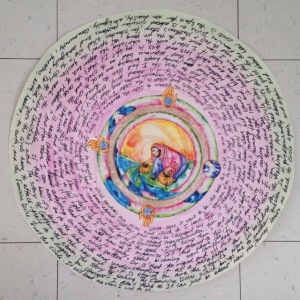 So I cut out another large circle and I started another mandala. This time I started with an image that reflected the work of writing the book (a woman gathering water at a stream – a reflection of me gathering the ideas that I would use to water the seeds I have planted). Around the image, I started writing intuitively about what I thought the book would become. As I wrote, more and more ideas started flowing, and the concept for the book grew in a way that felt wild and outside of my control.
So I cut out another large circle and I started another mandala. This time I started with an image that reflected the work of writing the book (a woman gathering water at a stream – a reflection of me gathering the ideas that I would use to water the seeds I have planted). Around the image, I started writing intuitively about what I thought the book would become. As I wrote, more and more ideas started flowing, and the concept for the book grew in a way that felt wild and outside of my control.
That’s when I started to get nervous. Because maybe this book is bigger than me. Maybe it’s bigger than just a nice little memoir that those who already love my work will cozy up in their armchairs to read and then pass on to their friends. Maybe it will require more courage than I expected because I’ll be nudged to say counter-cultural things that won’t sit well with the dominant culture and revolutionary things that will be taken seriously by people longing for change. Maybe I’ll even offend people and make those close to me wonder why I’m acting “too big for my britches”.
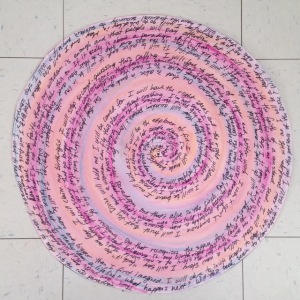 That mandala didn’t leave me feeling any more settled than the other, so I grabbed another circle and kept going. This time I had to deal with the resistance that kept showing up to let me know I am not worthy of this book, not capable of writing a book that will invite change in the world, not spiritual enough, not smart enough, not organized enough, not rich enough, not influential enough, etc. etc.
That mandala didn’t leave me feeling any more settled than the other, so I grabbed another circle and kept going. This time I had to deal with the resistance that kept showing up to let me know I am not worthy of this book, not capable of writing a book that will invite change in the world, not spiritual enough, not smart enough, not organized enough, not rich enough, not influential enough, etc. etc.
This time I used the spiral that shows up a lot in my mandala journaling. The spiral is usually used like a labyrinth, inviting the release on the inward journey, the receiving at the still point at the centre, and then the return that brings whatever gift was received at the centre back out into the world. I coloured a spiral with chalk pastels, and then spiraled inward with my Sharpie marker, trying to release the resistance and the voices of self-doubt. At the centre, I paused in stillness, and then began the return, journaling about the gift that this book could be and what I was being called to bring to it. When I reached the outer edge, there was still resistance in me, so I began the journey back to the centre and once again out to the edge.
That journey brought me back to the term “paradigm shift” and that’s when I started to get really freaked out. Because that term transported me back to the hospital when I was waiting for Matthew to arrive. It took me back to those transformational three weeks when some pretty unusual and remarkable events occurred, including some that I hardly ever talk about because they’re hard to explain. Events that included other-worldly visitors and grand visions and even prophecies (some of which have come true since then). Events that felt big and scary and made me feel like I had some kind of Messiah-complex every time I tried to talk about them. In one of those unusual events, the term paradigm shift was spoken to me, and not by anyone physically present in the room. It left me with an unsettled feeling that I might be called into the kind of change-making work that few people around me would understand.
And that’s when I started to realize that the two books – the one I set aside about the events surrounding Matthew’s death and birth and the one about the paradigm-shifting power of circles might actually be one and the same. Sitting in that art room, playing with chalk pastels and markers, a gradual awareness was growing in me.
Fourteen years ago, when I was in that hospital room for three weeks, a paradigm shift was growing in me, inviting me into something new, a little scary, and much bigger than me. Since that time in the hospital, that paradigm shift keeps showing up as some form of circle.
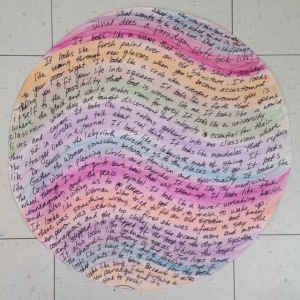 I cut another circle, used chalk pastel to colour the waves of change across it (that reflects the Two Loops that I learned from Deborah Frieze), and started journaling again. This time, I asked myself what a paradigm shift looks like and why it matters. I also asked myself how the paradigm shift had shown up in my life in the fourteen years since the term had attached itself to me in the hospital. Every one of those times it showed up could somehow be linked back to the circle. Sometimes it was in the many circles of people I’ve been part of and hosted over the years, sometimes it was at the centre of the labyrinth, sometimes it was while I made and taught mandala journaling, and sometimes it was in models like Theory U and the Two Loops that use the curve as their primary shape.
I cut another circle, used chalk pastel to colour the waves of change across it (that reflects the Two Loops that I learned from Deborah Frieze), and started journaling again. This time, I asked myself what a paradigm shift looks like and why it matters. I also asked myself how the paradigm shift had shown up in my life in the fourteen years since the term had attached itself to me in the hospital. Every one of those times it showed up could somehow be linked back to the circle. Sometimes it was in the many circles of people I’ve been part of and hosted over the years, sometimes it was at the centre of the labyrinth, sometimes it was while I made and taught mandala journaling, and sometimes it was in models like Theory U and the Two Loops that use the curve as their primary shape.
The more I sat with the idea and the more I brought it to the mandala, the more I realized the ideas that have become so much a part of my work all had their seeds planted in me as I sat in a hospital room waiting for my son to be born. If I were to chart my life’s work (and the book) on the story arc, that time in the hospital, when I had to put my busy life on hold to try to protect the life of my unborn son, was the “inciting incident” that was the catalyst for everything that came afterward.
I have always known that my son Matthew’s short life, that was only lived in the confines of my womb, was as meaningful as any that had been lived out for ninety years on this earth. This revelation in the art room was even more confirmation of that. If I hadn’t paused to spend those three weeks with Matthew, I would never have found myself here, doing this work, fourteen years later.
So much was swirling around my head by then that I cut out more circles and kept going. I knew I had more work to do before I was ready to sit at a computer and string the words together that would tie the old pieces of the puzzle in with the new, so I stayed in the art room.
One of the mandalas was a “through” mandala that is one of the lessons I teach in Mandala Discovery, where the idea/emotion/challenge you’re traveling through is written in large letters across the circle. (In my case I wrote “circle”.) The journaling then follows a meandering path in and out and across the word at the centre, allowing the questions, fear, invitation, resistance, and excitement to show up in all its complexity and unpredictability. Another one started with a spiral at the centre that reflected the central theme of the book and then smaller spirals spreading out around it that reflected the secondary themes. In a third, I placed an image at the centre that was a reflection of me, making an offering of the book to the world. Spreading out like the sun’s rays, I wrote what might become chapter headings in the book. In the fourth, a flower represented the blossoming of the ideas in the book. In the final one, I found a new, bigger and bolder image that reflected what the way that the book could potentially serve the world, and journaled about what my thoughts were now that I’d worked through these fresh ideas and all of the resistance that came along with it.
 By the time I had finished all of these mandalas, it was Wednesday morning and nearly time to leave the retreat centre. I had just enough time to sit down at my computer, write a couple of pages of what would be the new version of the book, and then re-open the file that held the old version of the book.
By the time I had finished all of these mandalas, it was Wednesday morning and nearly time to leave the retreat centre. I had just enough time to sit down at my computer, write a couple of pages of what would be the new version of the book, and then re-open the file that held the old version of the book.
In the last couple of years, each time I’ve opened that file, I was filled with a sense of uneasiness, discomfort, and disappointment that I couldn’t seem to bring this project to completion. I’d read a few paragraphs or flip through the pages, but always close it in frustration. This time was different. This time there was freshness and hope and a new sense of possibility.
There is still a lot of work ahead of me. There will be lots of moments of self-doubt and resistance. I’ll get lost in the challenge of stringing together complex ideas and this new, emerging paradigm. But at least I now have a clearer picture of what wants to be born. And I have my mandalas to return to when I get lost.
I expect there will be many more mandalas made before this book is published. Here’s hoping that a publishing date will happen in 2015.
If you want to use mandala-journaling as a planning tool, you might want to start with A Soulful Year. If you want to use it as a tool for self-discovery, try Mandala Discovery.
by Heather Plett | Oct 14, 2014 | journey, Labyrinth, mandala, painting, Passion, Spirituality, Uncategorized
I often use labyrinths in my retreats and workshops, and until now I’ve either used what’s available onsite, or I’ve created them with string, mowed them into grass, or made them out of dried leaves.
This weekend, I finally made a portable labyrinth that I can carry with me.
 When I shared the result on social media, several people asked for details about how I made it. Here’s how:
When I shared the result on social media, several people asked for details about how I made it. Here’s how:
 1. Since canvas can be quite expensive, I looked for a less expensive alternative. At the local Home Depot, I found painting drop cloths that were 4′ x 20′. They worked well because they’re fabric on one side and plastic on the other so that they absorb the paint without soaking through to the floor. Plus they’re fairly light weight for easier transport. (They cost $22 each, so my total investment was $110, since I had all of the other materials on hand.)
1. Since canvas can be quite expensive, I looked for a less expensive alternative. At the local Home Depot, I found painting drop cloths that were 4′ x 20′. They worked well because they’re fabric on one side and plastic on the other so that they absorb the paint without soaking through to the floor. Plus they’re fairly light weight for easier transport. (They cost $22 each, so my total investment was $110, since I had all of the other materials on hand.)
2. I wanted to make my labyrinth approximately 20′ x 20′, so I bought 5 drop cloths and sewed them together. They’re hemmed along the long edges, and at first I was going to seam-rip all of the hems, but that was far too tedious, so I just cut off the hems (losing a bit of the width, but I was okay with that) and sewed them. Tip: I had access to a large space for my labyrinth creation (a church floor), and I recommend doing the sewing in a fairly large space too. It’s bulky and a little awkward.
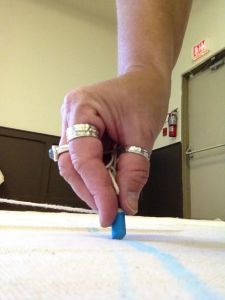 3. Once the dropcloths were sewn together, I drew the outline of the labyrinth with chalk. I started by measuring where my centre was and making a chalk mark there. Then I placed a paint can at the centre and tied a long string loosely on it to use as a giant compass/protractor. Tip: Make sure the string is loose enough on the can so that it rotates as you move around the circle.
3. Once the dropcloths were sewn together, I drew the outline of the labyrinth with chalk. I started by measuring where my centre was and making a chalk mark there. Then I placed a paint can at the centre and tied a long string loosely on it to use as a giant compass/protractor. Tip: Make sure the string is loose enough on the can so that it rotates as you move around the circle.
4. I wanted to make a 5-path version of the Chartres labyrinth. To figure out how wide my paths should be, I started by making the largest circle (to within a couple of inches of the edge of the canvas) and then making the centre circle (large enough that three people can comfortably stand in it). Then I measured the distance between the centre circle and the outside circle and divided it by 5. It came to 17.5 inches.
5. Shortening my string each time, I drew the concentric circles. 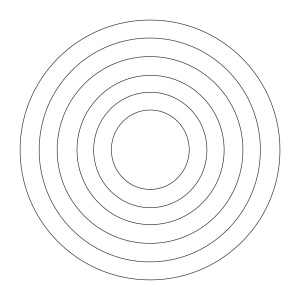
6. From there, it’s a matter of drawing the horizontal and vertical lines and then erasing the parts of the circle that aren’t needed. As you’ll see in the design I used, the horizontal and vertical lines all connect circles, so you need to pay attention to which of the circles you’re connecting, and then measure the same width as your path (17.5″ in my case) from that line to know how much of the circle to erase. Tip: The chalk marks are easy to brush away with a household brush (I used a pot scrubber).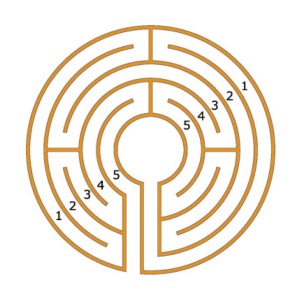
7. Once I had the chalk lines in place, I started painting. To keep it inexpensive, I used some leftover acrylic house paint for my lines, which worked great. I painted on the inside of each chalk line to keep it consistent.
8. For the width of the lines, I simply painted as wide as a small sponge brush. The edges of my lines are not very precise, since it’s hard to attain precision on fabric without driving yourself crazy, but I decided I was fine with that. It might have worked to put painters tape down, but that seemed like a lot of extra work to me (and I only had the space for a limited time) and I wasn’t sure how the tape would work around circles.
 9. After the paint had dried, I decided to touch up the edges a bit with a thinner brush. It took a fair bit of extra time, but I liked the more solid line, so it was worth it.
9. After the paint had dried, I decided to touch up the edges a bit with a thinner brush. It took a fair bit of extra time, but I liked the more solid line, so it was worth it.
10. I let it dry for about 12 hours before folding it. It might have been a good idea to leave it longer, but the space was being used the next day so I needed to move it.
The hardest part of the whole process was all of the time spent (about 8 hours) crouching on the floor. By the end of it, I had a hard time unfolding my body! Stretching during my breaks helped, but I could have been more diligent.
by Heather Plett | Sep 12, 2014 | grief, mandala, Uncategorized
 Hardly a week goes by that I don’t get an email with words like “How do you get through the rough spots in life?” Or “I feel lost. What should I do?” Or “What do you do when you are in despair?”
Hardly a week goes by that I don’t get an email with words like “How do you get through the rough spots in life?” Or “I feel lost. What should I do?” Or “What do you do when you are in despair?”
Some people are looking for coaching, some are simply asking for advice, and some have read a blog post about my own personal rough spots and think that I might have some wisdom to share. “You seem to know how to walk through the rough spots with strength and resilience,” the emails often say. “I want to know how to do that.”
Depending on the situation and the depth of the despair, I might take them on as clients, I might offer them a story or some encouragement, or I might recommend they see someone else who’s better qualified for the particular challenge the person is going through.
Hardly ever do I feel qualified to give them advice. Most of the time when I get these emails, my first reaction is “But… I’m not an expert in navigating despair. All I do is muddle through. And sometimes I feel so completely mired in it, I feel like I’m drowning. How could I possibly be of service to others?”
Last week was one of those times when I doubted my own ability to offer anything of value. Not that I was in a particular place of despair myself, but rather that I saw so much of it in the world around me that I felt completely inadequate.
Three of those emails came within the span of three days. I put off answering them, weighing my words and wanting to offer what was of the most value. Wanting, most of all, to leave these people feeling like they were not alone and that there is some tiny point of light in their darkness.
Before I had a chance to respond to any of them, I found out that an old friend (who’d been my roommate when I was 19 and entering the minefield of adulthood and independent living) was killed in a tragic car accident and had left behind three daughters just a little older than my daughters. I haven’t kept in touch with her much in recent years, so it wasn’t so much that I felt a huge hole in my own life, but I kept thinking about the people – her daughters, husband, parents, siblings, etc. – who do have huge holes in their lives. How can it be fair that three young daughters now have to navigate adulthood, parenthood, and all of the other things that are coming in their future, without their mother? Why did she have to die only a week after celebrating her daughter’s marriage?
And then I extended those thoughts and that grief to my own story and all of it felt too overwhelming. What if I lose my brother? What if my niece and nephew lose their dad just as they’re moving into adulthood? What if my sister-in-law has to learn to walk in the world as a widow?
I came home from the memorial service feeling completely raw and spent. My well was empty. I had nothing to offer, no resources to draw on. I snapped at my kids when they argued and was abrupt with my husband when he asked for something. I didn’t want to be the grown-up in any situation, much less the coach or teacher that people turned to while trying to navigate the darkness.
After a good night’s sleep, I woke up feeling a little more able to be an adult. After driving the girls to school (without any snapping), I sat down to scan Facebook, and someone had shared a TED talk by Andrew Solomon about how the worst moments in our lives make us who we are. The timing couldn’t be more perfect. Solomon talks about how we forge meaning out of the difficulty in our life, and that meaning shapes our identity.
Ah yes. We forge meaning. That’s one of the most important things that I know about the times of despair. It may be almost impossible to see it when you are in the middle of the darkness, but when you emerge, you begin to make something meaningful out of all the broken pieces of your shattered life. And as your strength grows, you realize that you are who you are partly because you survived the darkness.
After having a stillborn son, for example, I knew that that experience had been a spiritual turning point for me. Nothing before in my life had left me more awakened and hungry for a deeper faith and spirituality. And nothing else had ever made it more clear to me that I needed to follow the path of my own calling rather than trying to conform to what was expected of me. My priorities became suddenly crystal clear. My life is vastly different than it might have been if I hadn’t landed in the hospital for the final three weeks of my pregnancy and then left the hospital with empty arms. I am wiser, stronger, more clear about who I am, and more spiritually awake.
Once you’ve picked yourself up and figured out how to make something meaningful out of the mess, a few things happen:
- You realize you are stronger than you thought you were. You look back at the darkness and realize that it didn’t conquer you. You have reserves of courage and strength you didn’t know you had.
- You begin to tell different stories about yourself. You are no longer a victim. You are no longer lost. You are a survivor.
- The next time you are faced with a challenge, you face it with a little more courage than you did the last one, because you know you are capable of surviving. You know the darkness can’t conquer you. You might still get knocked off your feet, but you have a little more faith that you’ll be able to get back up again.
In the book David & Goliath, Malcolm Gladwell shares a story of the air raids on London during the Second World War. Anticipating mass hysteria and intense anxiety, the government at the time built psychiatric hospitals in preparation. But the hospitals didn’t fill up. People were much less anxious than they’d expected. Why? Because they survived. Because the first time the bombs fell, they walked away from it and realized that they were still alive and could go on. Each time the bombs fell, they got a little stronger and more able to keep on going without being paralyzed by fear.
In Pathfinder and in many of my coaching sessions, I tell people to carry a basket of courage stories with them. “Write down the stories of times when you had courage,” I say, “and then when you need a reminder, go back into that basket, pull out the stories, and remember that you are a courageous person and you can survive the darkness.”
After watching the TED talk, I finally opened my email, determined to offer the best response I could to those who were reaching out, not because I was an expert, but because I was a survivor. I’ve been through the dark – many times. I know how to look for the points of light. I know how to take tentative steps even when my feet feel mired in clay.
As I began crafting my responses, I was reminded of one of my favourite quotes from George Bernard Shaw.
“I’m not a teacher: only a fellow traveler of whom you asked the way. I pointed ahead – ahead of myself as well as you.”
I don’t claim any expertise in despair navigation. I am not a psychologist or therapist. I am only a fellow traveler who has been through the darkness many times. Surviving rape, the death of my son, the suicide attempts of my husband, the death of my mom and dad, and many other challenges, didn’t make me an expert, but they taught me to survive and to forge meaning. And that makes me not an expert, but “a fellow traveler of whom you asked the way.”
If you are in despair, I offer you these small pieces of wisdom on navigating in the dark:
1. Believe that it will one day be better than this. Nobody stays in the darkness forever. There is an ebb and flow to every life. We walk through it all and none of it lasts forever. You may not see light today, but perhaps tomorrow, perhaps next week or next month, the light will poke through.
2. Make something. There’s something about the act of production that helps make the darkness a little lighter. Bake a cake, draw a picture, make a model airplane – it doesn’t really matter what you make but it does matter that you get your hands busy and create something. One tiny act of productivity and one simple thing made by your own hands can shift a spiral of negative stories going on in your head. When my husband was in despair in the psychiatric ward, the only time I saw light in his eyes was when he was making a model airplane in the art room.
3. Move your body. Get active. Run, dance, walk, swim – do something to get your muscles moving, your heart rate up, and your adrenalin flowing again. A little dopamine flowing in your brain can help you see the points of light in the darkness. Start with something simple – walk around the block.
4. Pray. Even if you don’t have a particular faith, prayer helps. Reach out to the God of your understanding, your Higher Power, even if the only word you say is “Help!” Look outside yourself for some source of hope. As Andrew W.K. says in this article, “‘Getting down on your knees’ is not about lowering your power or being a weakling, it’s about showing respect for the size and grandeur of what we call existence — it’s about being humble in the presence of the vastness of life, space, and sensation, and acknowledging our extremely limited understanding of what it all really means.” (If prayer is unfamiliar to you, or you need some prompts, Prayer Stones might help.)
5. Talk to someone. You’re not meant to survive this time of despair alone. We are social animals – we’re meant to live in community. There is no shame in asking for support. Start with a friend, family member, or someone you trust. Or reach out to your doctor, find a therapist, or look into grief coaching. If you need someone to help you find a place to start, you can contact me. I don’t have the answers for everything, but I know a lot of people working in helping professions – one of them might be the right person for you.
6. Get outside. Stand in the sunshine. Get fresh air. Lean on a tree. Nature heals. Breathe in the oxygen the trees offer as a gift, watch the seasons change, and remind yourself of the way the earth regenerates herself, moving from death to life and back again. Spring comes back every year. Life returns to the landscape that lies dormant under the snow.
One of the people who’d emailed me earlier had made a special request of me. It wasn’t advice or coaching she was looking for – she simply wanted me to pray and make a prayer mandala for her. And so I did, because – like it says above – prayer helps, and making something helps. I made it for her and I made it for myself and I made it for all of the other people around me who are currently in despair.
With my house full of stones these days, I decided to make a prayer mandala out of stones. I started at the centre, choosing a few Prayer Stones. 
The mandala grew, and at the outer edges I added Intention Stones that reflected the meaning that I have forged out of my own times of despair and that I wish for those still in it.


The act of making the mandala, even without any words coming out of my mouth, was my prayer, my offering up of those things that are outside of my control and outside of my understanding, and my way of catalyzing the overwhelm and feeling of inadequacy.

May you find your way through whatever challenge you find yourself in and will you know peace and grace. And may the meaning that you make of it all become the gift you offer the world.
Prayer Stones and Intention Stones are available in my Etsy Shop. And if you’re interested in being part of a coaching circle that will help you find your way, check out Pathfinder Circle, starting again on September 30th.
by Heather Plett | Sep 9, 2014 | mandala

The Magic of Mandalas Blog Hop is a radically inspiring sharing circle, with artists from around the globe sharing the stories behind their process of creating mandalas. Our mission: To inspire you to see new possibilities for your own creative practice.
Click here to discover new artists, soak up new ideas and fill up on creative inspiration to fuel your creative practice.
I love words. I always have and I always will. Words have come naturally to me since I started my first journal at the age of ten. Nearly every major event in my life – whether hard, easy, good, or bad – has been processed in my journal through words. Most of my career, in fact, was guided by words – I worked as a professional communicator.
But sometimes words are not enough.
Sometimes words limit the brain, keeping it stuck in old patterns. Sometimes you need more than just words. And sometimes things happen that are too monumental, too confusing, or too full of pain or beauty to put to words.
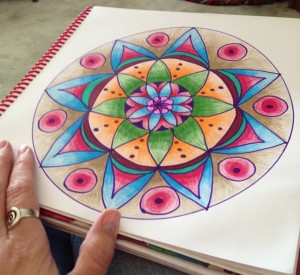 That’s when I turn to mandalas. Mandalas open spaces in the brain that words can’t access. Mandalas tap into the creative right brain processes that move us through things in fresh and often surprising ways. Mandalas help us shift into a more mindful space where the words spinning through our minds are silenced for awhile and the real wisdom can speak.
That’s when I turn to mandalas. Mandalas open spaces in the brain that words can’t access. Mandalas tap into the creative right brain processes that move us through things in fresh and often surprising ways. Mandalas help us shift into a more mindful space where the words spinning through our minds are silenced for awhile and the real wisdom can speak.
Right now, people are working their way through the September offering of Mandala Discovery, and I am enjoying the sharing that’s going on in the Facebook group. People are often surprised by what is cracked open by the Mandala Journal prompts.
“It feels so nurturing to me – like my soul is starving for this kind of thing, and I finally get to feed it what it wants,” said one person.
“My Inner Child emerged,” said another. “I got memories of being afraid and turning to nature to make me feel safe.”
“I love how a mandala can be simple and still be deep, complex and beautiful,” said a third.
Often my mandalas combine words with images, accessing both right and left brain patterns. If you want to try a unique mandala process that’s about stopping the spiral of self-doubt, here’s one.
The next offering of Mandala Discovery will be in January 2015, with registration opening in December 2014. Add your name to my email list (on the top right) to stay informed.
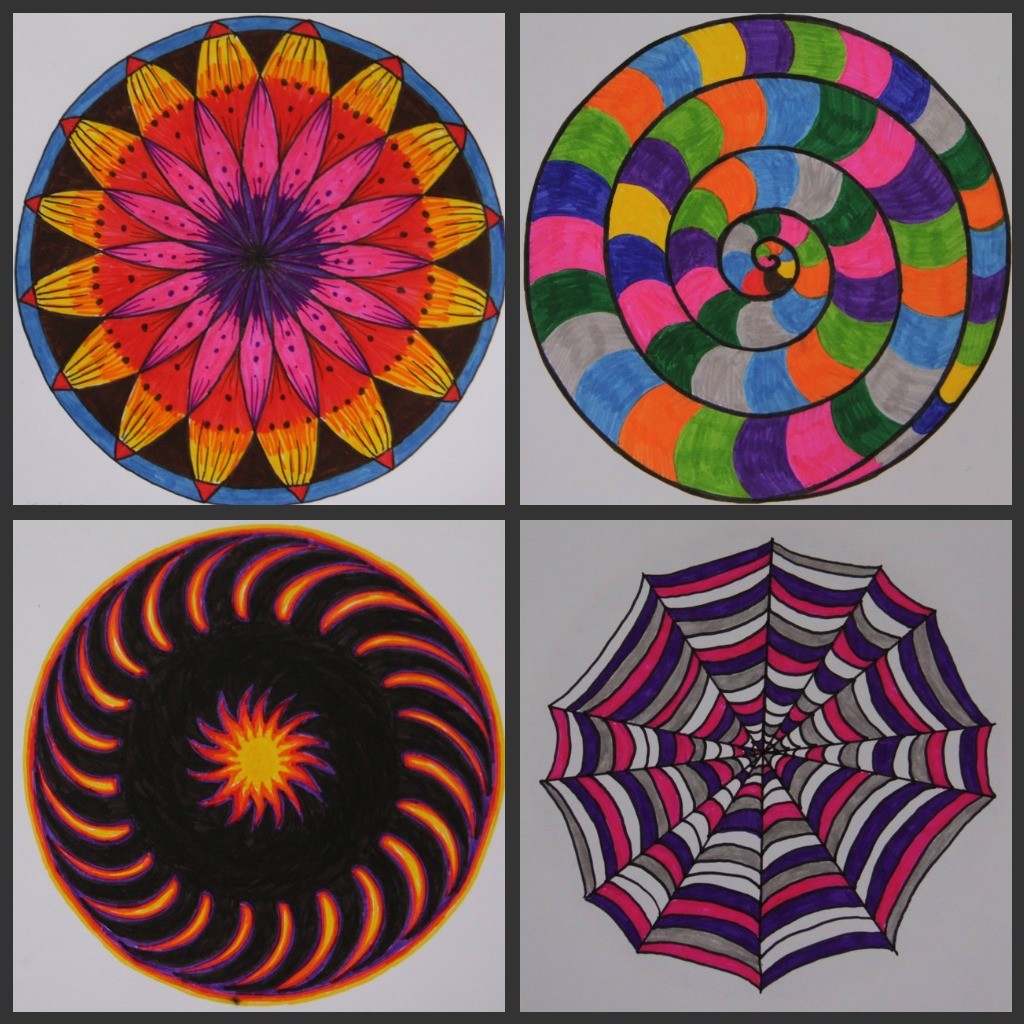
by Heather Plett | Aug 29, 2014 | mandala, Uncategorized
This is a re-share from back in February. I’m bringing it forward again, partly because Mandala Discovery starts again September 1st, and partly because the topic seems timely for some of the things going on in the world around us right now.
Last week I attended a vigil for two people whose bodies had been found in the river. Both were First Nations. Both were living marginalized lives, victims of generations of injustice. One was a homeless man who struggled with addiction. He was known in our city as the Homeless Hero because he’d saved two people from drowning a few years before his own life ended in the same river. The other was a 15 year-old-girl who ran away from a foster home, was exploited and then murdered.
At the same time, in the U.S., the passionate response to a young black man’s death at the hands of the police in Ferguson continues to remind us that the world does not treat all young men equally.
As a woman born into white privilege, I did not “earn” better treatment than any of these three people did, and yet it is almost certain that I would have been treated better in almost every circumstance than any of these three people were. It’s not fair, and I can feel helpless in the face of it and choose to hide my head in the sand and pretend it doesn’t matter, or I can choose to be awake to what I see, choose to be honest about where the problems are, and choose to own my lineage with all its flaws and imbalances.
We all have our historic stories that feed into who we are and how we walk in the world. I come from a Mennonite heritage, and so I carry with me the roots of pacifism and stories of the abuse my ancestors faced in Russia because of it. Those stories may feel far away, and yet they are part of who I am.
If you want to explore your own roots, here’s a Mandala Journal process that might help you do that.
If this feels meaningful to you and you’d like to receive a prompt like this in your inbox once a day for 30 days, sign up for Mandala Discovery, starting September 1st.
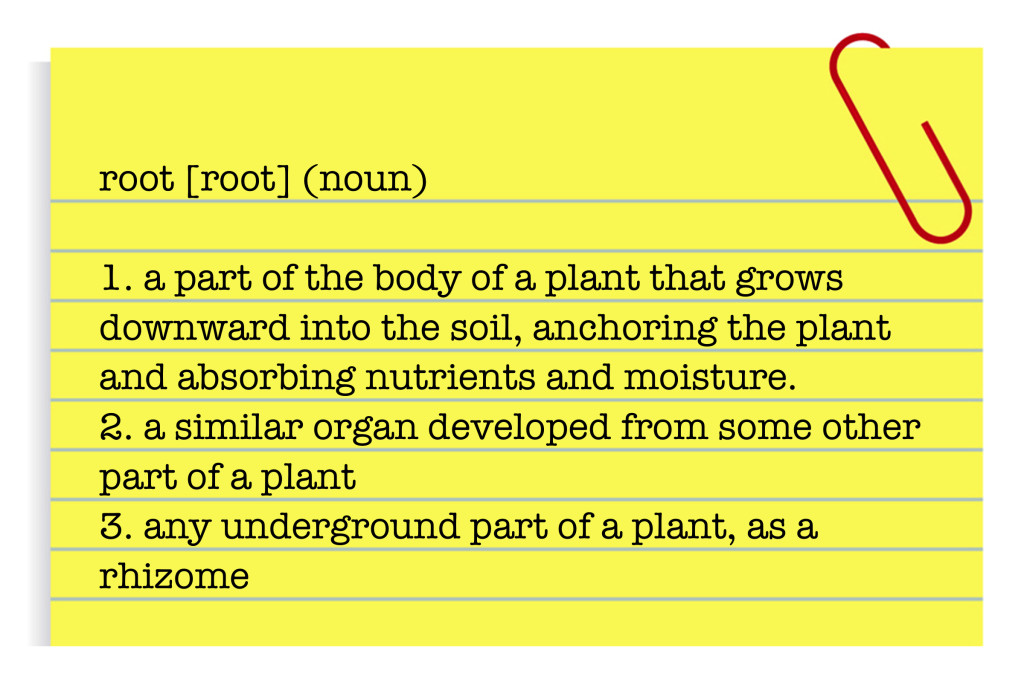
Where Your Roots Grow
A couple of years ago, I had the privilege of participating in a healing circle for people who’d been impacted by residential schools in our country. This is a tragic chapter of Canada’s history in which Aboriginal children were taken from their families and placed in boarding schools where they were denied their own cultural practices and language, and many were physically and emotionally abused.
A few of the people in the circle had been students at residential schools, but more of them had been raised by parents who were forced to attend residential schools. And then there were those of us who didn’t have residential schools in our blood line, but knew that we were impacted nonetheless, because our community members were impacted and because we were raised as white Canadians with a colonial history. Some of our ancestors undoubtedly shared in the guilt of this injustice.
As we listened to the stories shared around the circle, it was clear that all of us carried both the wounds and the wounding of our ancestors. It was especially apparent in those who’d been raised with parents who’d been in residential schools. Some of them spoke of alcoholism, family abuse, cultural neglect, and other stories that clearly left deep wounds in their collective psyche.
Whatever our roots are – whether we were raised in a lineage of oppressed or oppressors, religious or agnostic, poverty or wealth – we all carry the stories of our ancestors with us.
Our roots reach much deeper into the soil of our family’s past than we ever fully understand. We are impacted by the history that happened in our bloodline long before we were conceived and born into this world.
Bethany Webster talks about the importance of healing the mother wound. “The mother wound is the pain of being a woman passed down through generations of women in patriarchal cultures. And it includes the dysfunctional coping mechanisms that are used to process that pain.” The mother wound manifests itself in our lives as shame, comparison, the feeling that we need to stay small, allowing ourselves to be mistreated by others, and self-sabotage. If we do not heal it, she says, we continue to pass this wound down through the generations.
We must also consider the ways in which patriarchy has impacted men. As Richard Rohr says, “After 20 years of working with men on retreats and rites of passage, in spiritual direction, and even in prison, it has sadly become clear to me how trapped the typical Western male feels. He is trapped inside, with almost no inner universe of deep meaning to heal him or guide him.” Men have to come to terms with their own wounds and often have little support to find healing for them.
These stories that we carry from our past – that we are not worthy, that we need to stay small, that we are not allowed to show emotion, that our cultures don’t have as much value as that of our colonizers, or that we are not allowed to do anything that goes against our religion for fear of hell – they are the soil in which our roots grow. If that soil is not fertile and nurturing, our growth is impaired and we never reach our full potential.
Imagine, though, that through an alchemical process, these stories can be healed and transformed and can become the fertile soil we need for healthy growth. Imagine that they can provide rich fertilizer to feed our roots and make our branches grow and our fruit to be plump and sweet.
We can transform these stories. They do not need to keep us small. They do not need to hold us back from what we can become.
Through much inner work – whether that looks like therapy, journaling, dance, meditation, mandala-making, or any other form of self-discovery and healing – we can cultivate those stories and stir them like a compost heap until they become the richest of fertilizer. This is not easy work, and it is not short-term work, but it is necessary work. The world needs us to heal and the world needs us to grow strong and true.
After reading the article by Bethany Webster, about the need to heal the Mother Wound, I wrote a letter to my mom. She died last year, so she won’t read it on this earth, but I still felt like there were some things I needed to say to her. I acknowledged the way that she had been wounded (by losing her mother when she was six, for example) and forgave her for the way that those wounds were passed on to me. I thanked her for the love she poured on me and my siblings despite the deep wounds she carried. Writing the letter felt significant – like I had begun to heal something for both myself and for her. There is more work to do, but every step toward healing is a step in the right direction.
Consider what Charles Eisenstein says about how our healing can contribute to the world’s healing (in “The More Beautiful World Our Hearts Know is Possible”):
“When I see how my friend R. has, in the face of near-impossible odds, so profoundly healed from being abused as a child, I think, ‘If she can heal, it means that millions like her can too; and her healing smooths the path for them.’
“Sometimes I take it even a step further. One time at a men’s retreat one of the participants showed us burn scars on his penis, the result of cigarette burns administered by a foster parent when he was five years old to punish him. The man was going through a powerful process of release and forgiveness. In a flash, I perceived that his reason for being here on Earth was to receive and heal from this wound, as an act of world-changing service to us all. I said to him, ‘J., if you accomplish nothing else this lifetime but to heal from this, you will have done the world a great service.’ The truth of that was palpable to all present.”
Eisenstein goes on to talk about scientific research into “morphic resonance” in nature – the concept that once something happens somewhere, it induces the same thing to happen elsewhere. Some substances, for example, are reliably liquid for many years until suddenly, around the world, they begin to crystallize. It is not clear why it happens, when these substance are not in contact with each other or exposed to the same environment, but it seems that a change to one begins to result in changes to others. In the same way, he says, the healing of one person can lead to the healing of others, even if those people never meet.
Transforming your stories into rich soil so that you can grow strong is necessary not only for you, but for the world.
Your Roots Mandala
Imagine you are a tree, firmly rooted in the stories of your past. Some of these stories are conscious for you (memories from childhood) and some are less conscious but you are impacted by them nonetheless.
Begin by drawing a large circle. In the centre of the circle, draw a small circle that represents the trunk of a tree. Reaching out from that trunk into the fertile soil around it, draw the roots of that tree. (Imagine you are looking down on the tree from above and can only see that part of the tree that is underground, not the branches or leaves.)
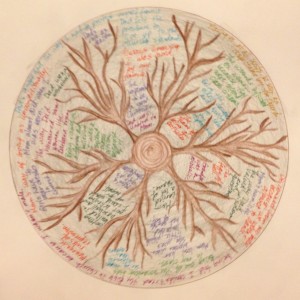 Between the roots, write down stories that are part of your past. Start with the stories that you know have impacted you and your growth in both positive and negative ways. Your religious upbringing, your father’s temper, your mother’s insecurity, your grandmother’s way of making you feel special, your birth order, your childhood abuse, etc. Do not censor yourself – if a story shows up, there’s a good chance it had an impact on you whether or not you recognize it. (There is no right or wrong way to do this – your stories are your own and you know what matters to you.)
Between the roots, write down stories that are part of your past. Start with the stories that you know have impacted you and your growth in both positive and negative ways. Your religious upbringing, your father’s temper, your mother’s insecurity, your grandmother’s way of making you feel special, your birth order, your childhood abuse, etc. Do not censor yourself – if a story shows up, there’s a good chance it had an impact on you whether or not you recognize it. (There is no right or wrong way to do this – your stories are your own and you know what matters to you.)
Reach further back. What are the stories that impacted your lineage before you were born? Your family’s displacement from the country they called home, your grandmother’s abusive marriage, your ancestors’ connection to colonialism or oppression, your grandfather’s death when your mother was small.
Write them all down. Some of them may bring up pain, and some may bring up positive memories. Some may have a clear impact on your life, and some you may not fully understand until a much later date. They are all part of your narrative and they are all part of the soil in which your roots dig for nourishment.
With a black pencil crayon, shade over the stories you have written, imagining that all of them are now becoming part of the compost that helps you grow. Whether good or bad, those stories are your soil.
Note: This exercise may bring up a lot of mixed emotions for you. It may feel like a little bit of healing, or it may feel like you’ve opened a wound that is still raw. That’s all part of the healing process. Sit with whatever comes up and do not try to suppress it. If you need to, do some further journaling to explore what came up, or find someone you trust that you can talk to about this.
You can find a downloadable pdf of this lesson here.
Did you find this useful? Consider signing up for the September 2014 offering of Mandala Discovery: 30 Days of Mandala Journaling. You’ll get 30 more like this.
 Last year, as the year ended, I shared a special mandala prompt for reflecting on the passing year before you invite in the new year. In that prompt, you were invited to divide your circle into 4 quadrants, with the words “grace, grief, growth, and gratitude” in each of the four quadrants. Then, with some reflection of the year that had passed, you filled each of the four quadrants with the things that happened that were connected to those four words.
Last year, as the year ended, I shared a special mandala prompt for reflecting on the passing year before you invite in the new year. In that prompt, you were invited to divide your circle into 4 quadrants, with the words “grace, grief, growth, and gratitude” in each of the four quadrants. Then, with some reflection of the year that had passed, you filled each of the four quadrants with the things that happened that were connected to those four words. It’s quite possible that some items will show up in multiple jars. For example, something that causes grief will probably also offer you opportunities to grow. And sometimes (like when friends show up to support you) grace shows up in the darkest of moments.
It’s quite possible that some items will show up in multiple jars. For example, something that causes grief will probably also offer you opportunities to grow. And sometimes (like when friends show up to support you) grace shows up in the darkest of moments.



 Some surprises showed up, and some things challenged me to think bigger than I’d thought before. For example, I’m not sure where “outrage” came from, but it wouldn’t leave me alone until I put it on the page. And when I added “A time of change” I began to open myself to the possibility that I was being called to write something that would invite people into significant cultural paradigm shift. While that idea was exciting, it started to feel bigger than what I’d allowed myself to dream.
Some surprises showed up, and some things challenged me to think bigger than I’d thought before. For example, I’m not sure where “outrage” came from, but it wouldn’t leave me alone until I put it on the page. And when I added “A time of change” I began to open myself to the possibility that I was being called to write something that would invite people into significant cultural paradigm shift. While that idea was exciting, it started to feel bigger than what I’d allowed myself to dream. So I cut out another large circle and I started another mandala. This time I started with an image that reflected the work of writing the book (a woman gathering water at a stream – a reflection of me gathering the ideas that I would use to water the seeds I have planted). Around the image, I started writing intuitively about what I thought the book would become. As I wrote, more and more ideas started flowing, and the concept for the book grew in a way that felt wild and outside of my control.
So I cut out another large circle and I started another mandala. This time I started with an image that reflected the work of writing the book (a woman gathering water at a stream – a reflection of me gathering the ideas that I would use to water the seeds I have planted). Around the image, I started writing intuitively about what I thought the book would become. As I wrote, more and more ideas started flowing, and the concept for the book grew in a way that felt wild and outside of my control. That mandala didn’t leave me feeling any more settled than the other, so I grabbed another circle and kept going. This time I had to deal with the resistance that kept showing up to let me know I am not worthy of this book, not capable of writing a book that will invite change in the world, not spiritual enough, not smart enough, not organized enough, not rich enough, not influential enough, etc. etc.
That mandala didn’t leave me feeling any more settled than the other, so I grabbed another circle and kept going. This time I had to deal with the resistance that kept showing up to let me know I am not worthy of this book, not capable of writing a book that will invite change in the world, not spiritual enough, not smart enough, not organized enough, not rich enough, not influential enough, etc. etc. I cut another circle, used chalk pastel to colour the waves of change across it (that reflects the
I cut another circle, used chalk pastel to colour the waves of change across it (that reflects the  By the time I had finished all of these mandalas, it was Wednesday morning and nearly time to leave the retreat centre. I had just enough time to sit down at my computer, write a couple of pages of what would be the new version of the book, and then re-open the file that held the old version of the book.
By the time I had finished all of these mandalas, it was Wednesday morning and nearly time to leave the retreat centre. I had just enough time to sit down at my computer, write a couple of pages of what would be the new version of the book, and then re-open the file that held the old version of the book.














 Between the roots, write down stories that are part of your past. Start with the stories that you know have impacted you and your growth in both positive and negative ways. Your religious upbringing, your father’s temper, your mother’s insecurity, your grandmother’s way of making you feel special, your birth order, your childhood abuse, etc. Do not censor yourself – if a story shows up, there’s a good chance it had an impact on you whether or not you recognize it. (There is no right or wrong way to do this – your stories are your own and you know what matters to you.)
Between the roots, write down stories that are part of your past. Start with the stories that you know have impacted you and your growth in both positive and negative ways. Your religious upbringing, your father’s temper, your mother’s insecurity, your grandmother’s way of making you feel special, your birth order, your childhood abuse, etc. Do not censor yourself – if a story shows up, there’s a good chance it had an impact on you whether or not you recognize it. (There is no right or wrong way to do this – your stories are your own and you know what matters to you.)